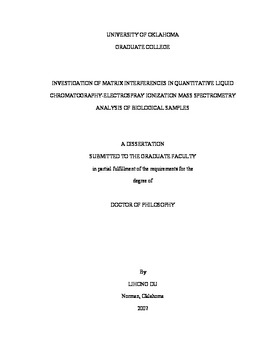| dc.contributor.advisor | White, Robert L., | en_US |
| dc.contributor.author | Du, Lihong. | en_US |
| dc.date.accessioned | 2013-08-16T12:20:36Z | |
| dc.date.available | 2013-08-16T12:20:36Z | |
| dc.date.issued | 2007 | en_US |
| dc.identifier.uri | https://hdl.handle.net/11244/1170 | |
| dc.description.abstract | The mechanisms by which endogenous GPCho lipids interfere with analyte electrospray ionization were investigated with the aid of a partition equilibrium mathematical model. A linear equation, which was derived by modifying previously published models, was used to quantitatively predict analyte MS responses. The correlation between analyte MS response and solution concentration was examined for four situations: analyte in solvent, analyte in solvent containing an HPLC compatible buffer, analyte in solvent containing a co-analyte, and analyte in solvent containing GPCho lipids and buffer. It was found that the experimental results could be explained by the linear equation of the new model over a wide concentrations range. The analyte behaviors in a salt solution, which could not be explained by the previous model, could be elucidated here. Moreover, the new model is easier to use for modeling solutions containing multiple species. It was concluded that analyte MS response was determined by a competition mechanism that was driven by equilibrium considerations and involved analyte and background electrolytes. | en_US |
| dc.description.abstract | Matrix interferences can severely affect the quantitative analysis of biological samples when electrospray ionization (ESI) is employed with liquid chromatographytandem mass spectrometry (LC-MS/MS). Before these effects can be eliminated or minimized, it is necessary to identify their sources. The role of glycerophosphocholine (GPCho) lipids in matrix interferences caused by the endogenous components in human plasma was investigated for assays involving representative pharmaceutical compounds. Conventional liquid-liquid extraction (LLE) was compared to high turbulent flow liquid chromatography (HTLC) online extraction and to ultra performance liquid chromatography (UPLC) as far as their abilities to reduce matrix interferences. GPCho lipids were found to be a primary source of matrix interferences for assays involving human plasma samples. Extraction solvents were unable to completely remove GPCho lipids. The efficiency for reducing the lipids by using online HTLC extraction was found to be dependent on the organic content of the transfer solvent employed. Turbulent flow had no significant effect on removing them. UPLC analysis eliminated lipid interferences by means of high resolution chromatographic separation. For the examined analytes, UPLC was more effective at removing lipid derived interferences than HTLC online extraction, which was more effective than conventional LLE. | en_US |
| dc.format.extent | x, 200 leaves : | en_US |
| dc.subject | Liquid chromatography. | en_US |
| dc.subject | Electrospray ionization mass spectrometry. | en_US |
| dc.subject | Chemistry, Analytical. | en_US |
| dc.subject | Blood plasma. | en_US |
| dc.title | Investigation of matrix interferences in quantitative liquid chromatography-electrospray ionization mass spectrometry analysis of biological samples. | en_US |
| dc.type | Thesis | en_US |
| dc.thesis.degree | Ph.D. | en_US |
| dc.thesis.degreeDiscipline | Department of Chemistry and Biochemistry | en_US |
| dc.note | Source: Dissertation Abstracts International, Volume: 68-04, Section: B, page: 2321. | en_US |
| dc.note | Adviser: Robert L. White. | en_US |
| ou.identifier | (UMI)AAI3261093 | en_US |
| ou.group | College of Arts and Sciences::Department of Chemistry and Biochemistry | |
